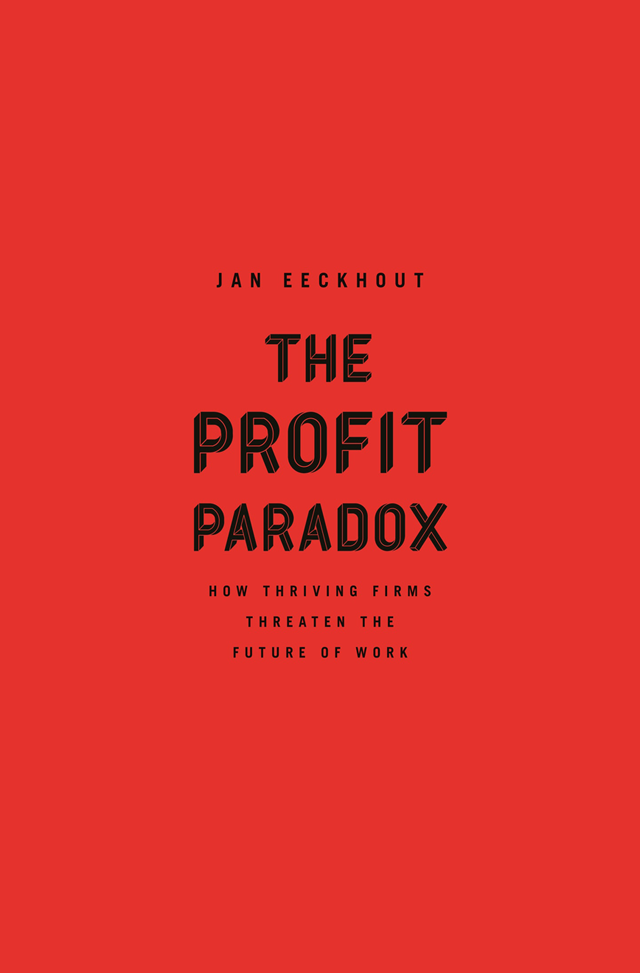Jan Eeckhout’s recent book The Profit Paradox is a serious attempt to explain rising market power and its implications to a wider audience. While parts of the book’s argument go beyond the research, it poses a starting point for serious debate and avenues for future research.
Traditional economic research on the topic of competition and market power has focused almost exclusively on prices and quantities in narrowly defined markets. This approach allows us to understand, for instance, how the merger of two large dairy producers will affect the price of milk. The traditional focus on prices and quantities in narrowly defined markets is not limited to economic research: it is the basis of antitrust enforcement policy and merger reviews.
A recent literature has taken a different approach to competition and market power. This research, in which I view myself as an active participant, aims to provide aggregate measures of market power and studies the implications for economy-wide outcomes, such as employment, wages, and the rate of turnover in labor markets. Early contributions focused on measuring aggregate market power and linking rising market power to stagnant wages since the early 1980s. More recent works link rising market power to the reduction in the rate of firm creation/destruction and to the reduction in the rate of turnover in the labor market, often referred to as declining dynamism.
While this new research has been endorsed by some senior economists, covered by the media, and is taken seriously by policymakers, it is not an easy topic to explain to a wider audience. It’s easy to communicate how the decline of unions or the rise of big employers could depress wages: a recently published paper aptly titled “Strong Employers and Weak Employees: How Does Employer Concentration Affect Wages” gets this point across clearly. Other explanations for stagnant wages, such as automation and outsourcing to low-income countries, are also easy to popularize—this was the centerpiece of Andrew Yang’s presidential primary campaign.
The Profit Paradox by Jan Eeckhout is a serious and significant effort to explain rising market power and its implications to decades of stagnant wages to a wider audience. Reaching a wider audience necessitates an exclusion of the measurement methods used by the author in his research and a discussion of the strengths and weaknesses of such methods. While the book does assume a degree of economic sophistication on the part of the reader, it is accessible to many who are either unable to or deterred from reading the underlying research. In addition, the book offers a more humane and engaging narrative than is present in academic research.
The book presents several examples of firms with high degrees of market power, including a description of how they reached their current position. A common theme of the examples, and indeed one that the book argues for directly, is that the forces of technology, especially information and communication technology and globalization, allow better firms to grow (a good thing) and that once fully grown, these firms “build a moat” to prevent others from competing (a bad thing).
Eeckhout is careful to distinguish between the micro effects (prices and quantities in narrowly defined markets) and the macro effects of market power. The author carefully explains that the rise of market power in a single industry has no macro effect, but an economy-wide increase in market power lowers wages. As evidence of a widespread increase in market power, the book combines results from recent research and draws on the readers’ familiarity with a large number of dominant firms operating in many different industries. Recognizing that this is not an easy argument, the heading where this argument is presented is a question “Why Does the Price of Beer Affect My Neighbor’s Wage?”.
There are parts of the book that go beyond what has been argued by research, most notably the argument that rising wage inequality and the rising college premium (the higher wages commanded by college graduates when compared to high school graduates) are the result of rising market power. I am sympathetic to the idea that top executives in the firm benefit from higher firm profits. I am also sympathetic to the idea that college graduates have disproportionately benefited from the technological advancement that the book points to as the source of the rise of dominant firms. However, I am not aware of sufficient analysis to date that supports the claim that rising market power can explain the value of going to college.
While I found aspects of the writing consistent with a negative outlook, Eeckhout does make clear that the rise of market power does not mean that we are worse off than in the past. Indeed, the book stresses on more than one occasion that the firms that are large are better and therefore produce at a lower cost than in the past. Some of these lower costs are passed on to consumers in the form of lower prices, but the majority lead to higher profits. This is what the book refers to as the Profit Paradox: better technology reduces costs, but the lack of viable competitors allows the dominant firms to keep most of the benefits to themselves and therefore most of the benefits don’t reach consumers or workers.
The book ends with recommendations for increasing competition in the US. These recommendations will divide opinion. Given the book’s focus on emergence of large firms and the impact of their market power on wages, the author offers three general policy prescriptions: (1) regulate large firms without breaking them up and set up data-sharing and other mechanisms that allow smaller competitors to thrive, (2) dramatically increase the scrutiny of mergers and acquisitions and revamp antitrust enforcement to reduce that ability of firms to stifle competition, and (3) require that the competition authority consider economy-wide effects in addition to prices, quantities and consumer welfare. I view these recommendations not as complete proposals (a big ask for any single book), but as a starting point of a serious debate and avenues for future research.
“Many proponents of stricter and stronger antitrust policy look at companies like Amazon and think that they need to be reined in or broken up. The Profit Paradox argues the opposite: Amazon and other large companies are too small.”
I want to conclude with a brief anecdote and an alternative formulation of what the book has coined the Profit Paradox, though I suspect this will make some proponents of tougher competition policy uncomfortable. Back in 2018, the Stigler Center held its annual competition conference on the topic of Digital Platforms and Concentration. The conference brought together researchers and policy makers to consider the implications of the dominance of a small number of tech companies. One session was dedicated to Amazon (titled “The Amazon Phenomenon”) and included as a panelist Lina Khan, the current chairperson of the Federal Trade Commission. I posed a question to those panelists that held negative views of Amazon: would it be a good or bad development if the then recently announced Amazon-Berkshire-JPMorgan venture to provide cheaper health insurance succeeded in providing cheaper health insurance. Those who were negative on Amazon were not interested in seeing it enter and dominate yet another market.
Many proponents of stricter and stronger antitrust policy look at companies like Amazon and think that they need to be reined in or broken up. The Profit Paradox argues the opposite: Amazon and other large companies are too small. The central thesis of the book, and of Eeckhout’s research, is that Amazon and other large firms are very productive, but don’t want to hire more workers or grow because in order to attract new consumers they would need to charge lower prices at the expense of profits. The logical implication of this work is that we should strive to make Amazon even larger than it is today and ensure that in the future other firms with better ideas are able to take Amazon’s place.







